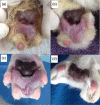Successful treatment of multifocal pedal Prototheca wickerhamii infection in a feline immunodeficiency virus-positive cat with multiple Bowenoid in situ carcinomas containing papillomaviral DNA sequences
- PMID: 28491447
- PMCID: PMC5415299
- DOI: 10.1177/2055116916688590
Successful treatment of multifocal pedal Prototheca wickerhamii infection in a feline immunodeficiency virus-positive cat with multiple Bowenoid in situ carcinomas containing papillomaviral DNA sequences
Abstract
Case summary: A 16-year-old, castrated male, feline immunodeficiency virus (FIV)-positive, domestic shorthair cat developed multiple skin lesions. Most of these were Bowenoid carcinoma in situ and contained DNA sequences consistent with Felis catus papillomavirus type 2. Two additional lesions that developed in the skin and subcutaneous tissues between the digital and carpal pads on the left forelimb and right hindlimb were shown by cytology, histology and culture to be caused by Prototheca wickerhamii. These lesions failed to improve in response to systemic therapy treatment with itraconazole, but excision by sharp en bloc resection with follow-up oral itraconazole therapy proved curative for one lesion, although the other lesion recurred, necessitating a second surgery.
Relevance and novel information: This is only the second reported case of feline protothecosis from Australia and the first case that has been cultured and identified to the species level. Also of great interest was the presence of multiple papillomavirus-associated neoplastic lesions, which may have afforded a portal of entry for the algal pathogen and the cat's positive FIV status; the latter might have impacted on both viral and algal pathogenesis by effects on immunocompetence.
Conflict of interest statement
Conflict of interest: The authors declared no potential conflicts of interest with respect to the research, authorship, and/or publication of this article.
Figures





References
-
- Davies R, Spencer H, Wakelin P. A case of human protothecosis. Trans R Soc Trop Med Hyg 1964; 58: 448–451. - PubMed
-
- Lerche M. Eine durch Algen (Prototheca) hervorgerufene Mastitis der Kuh. Berl Munch Tierarztl Wochenschr 1952; 4: 64–69.
-
- Ricchi M, De Cicco C, Buzzini P, et al. First outbreak of bovine mastitis caused by Prototheca blaschkeae. Vet Microbiol 2013; 162: 997–999. - PubMed
-
- Camboim EK, Garino FJ, Dantas AF, et al. Protothecosis by Prototheca wickerhamii in goats. Mycoses 2011; 54: e196–200. - PubMed
Publication types
LinkOut - more resources
Full Text Sources
Other Literature Sources
Research Materials
Miscellaneous
